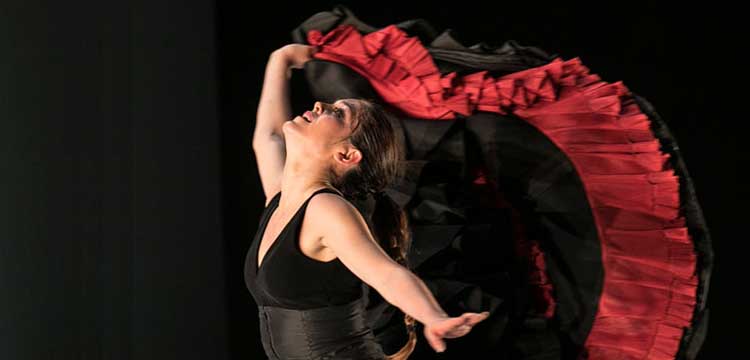23rd FESTIVAL DE JEREZ
Patricia Guerrero “Distopía”
Tuesday, March 5th, 2019. 2100h. Teatro Villamarta
(photos / video / reseña (spanish))
Estela Zatania
Dance: Patricia Guerrero. Guitar: Dani de Morón. Electric bass, upright bass: José Manuel Posada “Popo”. Percussion: Agustín Diassera. Voice: Sergio “El Colorao”. Lyrical song, actress: Alicia Naranjo. Dance: Ángel Fariña. Dance, actor: Rodrigo García Castillo. Artistic director, coreography: Patricia Guerrero. Stage director and script: Juan Dolores Caballero. Lighting design: Manuel Madueño.
You don’t need to understand. Sometimes it’s enough just to feel. Did I say “sometimes”? I think it may be all the time. Or at least, that’s how it ought to be when it comes to artistic endeavors. I don’t want anyone to explain the music of Bach, the paintings of Picasso or Patricia Guerrero’s “Distopía”. Without meaning to offend those two geniuses, I humbly offer the observation, after having last night been at the Villamarta theater, that great art needs no libretto.
In this 23rd Festival de Jerez, after twelve days during which we’ve seen some daring work (a phrase that sets off alarms) or ground-breaking creations (God help us), the person now talking to you, currently on probation after having been falsely accused of committing purism, offers Patricia Guerrero as exhibit number one in my defense. I saw her win the Desplante prize at the La Unión contest in 2007, very deservedly so, and I saw her last night, twelve years later. It can be said she has matured spectacularly, continues to do so, and the results can be enjoyed by nearly anyone.
Aside from the cliché of the sound “tick-tock” at the beginning and end, most of this work is refreshingly original thanks to the intelligence and good taste of Guerrero who is credited as artistic director and choreographer. There are some up-front flamenco moments, most notably the soleá and the alegrías, and as always, bulerías is the ointment that cures all. And when there’s no flamenco intent, the thread isn’t broken because it’s not narrative but sensory.
The physical language of Patricia Guerrero has little to do with that of anyone else. She employs robotic movements to great effect, just enough to surprise you or throw you off, lest anyone gets bored. She shuffles diagonally across the stage “walking” on her backside. She fascinates us in four by four time – mystery, passion, seduction and three men who have the effect of a Greek chorus with paper bags as masks worn over their heads, and a lovely pas de deux. It’s the school of “and why not?”
Essential and efficient elements: the brilliant guitar music of Dani de Morón, that of bassist José Manuel Posada “Popo”, the lyrical singing of Alicia Naranjo, the expressive dancing of Ángel Fariña and Rodrigo García Castillo, in addition to the flamenco singing of Sergio “El Colorao” and the percussion of Agustín Diassera. And look, I complain continually about the insufficient lighting in other works, but in this case the person responsible for lighting design, Manuel Madueño, deserves a monument.
